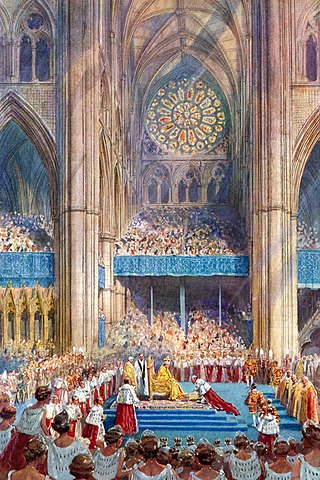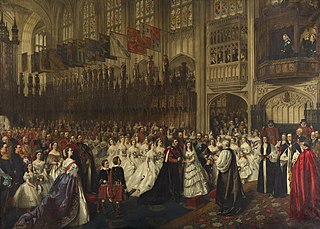
Tsarina or tsaritsa is the title of a female autocratic ruler (monarch) of Bulgaria, Serbia or Russia, or the title of a tsar's wife. The English spelling is derived from the German czarin or zarin, in the same way as the French tsarine / czarine, and the Spanish and Italian czarina / zarina. (A tsar's daughter is a tsarevna.)
A queen consort is the wife of a reigning king, and usually shares her spouse's social rank and status. She holds the feminine equivalent of the king's monarchical titles and may be crowned and anointed, but historically she does not formally share the king's political and military powers, unless on occasion acting as regent.
Princess Victoria or Viktoria may refer to:

The Crown Jewels of the United Kingdom, originally the Crown Jewels of England, are a collection of royal ceremonial objects kept in the Tower of London, which include the coronation regalia and vestments worn by British monarchs.

The coronation of the monarch of the United Kingdom is an initiation ceremony in which they are formally invested with regalia and crowned at Westminster Abbey. It corresponds to the coronations that formerly took place in other European monarchies, which have all abandoned coronations in favour of inauguration or enthronement ceremonies. A coronation is a symbolic formality and does not signify the official beginning of the monarch's reign; de jure and de facto their reign commences from the moment of the preceding monarch's death, maintaining legal continuity of the monarchy.
A queen dowager or dowager queen is a title or status generally held by the widow of a king. In the case of the widow of an emperor, the title of empress dowager is used. Its full meaning is clear from the two words from which it is composed: queen indicates someone who served as queen consort, while dowager indicates a woman continues to hold the title from her deceased husband. A queen mother is a former queen consort, often a dowager queen, who is the mother of the reigning monarch.

A queen regnant is a female monarch, equivalent in rank and title to a king, who reigns suo jure over a realm known as a "kingdom"; as opposed to a queen consort, who is the wife of a reigning king; or a queen regent, who is the guardian of a child monarch and rules pro tempore in the child's stead, be it de jure in sharing power or de facto in ruling alone. She is sometimes called a woman king. A princess regnant is a female monarch who reigns suo jure over a "principality"; an empress regnant is a female monarch who reigns suo jure over an "empire".

The Diamond Diadem, historically known as the George IV State Diadem, is a crown that was made in 1820 for King George IV. The diadem has been worn by queens regnant and queens consort in procession to coronations and State Openings of Parliament. It has been featured in paintings and on stamps and currency.

An Imperial Crown is a crown used for the coronation of emperors.

The Crown of Queen Mary is a consort crown that was made in 1911 for the coronation of British queen consort Mary of Teck. Mary thereafter wore it on occasion in circlet form. It is part of the Crown Jewels of the United Kingdom. It was used again, in a slightly altered form, at the coronation of Queen Camilla on 6 May 2023.

The Crown of Queen Alexandra was the consort crown of the British queen Alexandra of Denmark. It was manufactured for the 1902 coronation of King Edward VII and Queen Alexandra. It is now in the royal collection.

The State Crown of Mary of Modena is the consort crown made in 1685 for Mary of Modena, queen of England, Scotland and Ireland. It was used by future queens consort until the end of the 18th century.
A half-arch is the piece of gold, silver or platinum, usually decorated with jewels, that links the circlet of a hoop crown to the monde at the top of the crown.

The Crown of Queen Adelaide was the consort crown of the British queen Adelaide of Saxe-Meiningen. It was used at Adelaide's coronation in 1831. It was emptied of its jewels soon afterwards, and has never been worn since.

The Small Diamond Crown of Queen Victoria is a miniature imperial and state crown made at the request of Queen Victoria in 1870 to wear over her widow's cap following the death of her husband, Prince Albert. It was perhaps the crown most associated with the queen and is one of the Crown Jewels on public display in the Jewel House at the Tower of London.

The royal descendants of Queen Victoria and of King Christian IX, monarchs of the United Kingdom (1837–1901) and Denmark (1863–1906) respectively, currently occupy the thrones of Belgium, Denmark, Luxembourg, Norway, Spain, Sweden, and the United Kingdom. At the outbreak of the First World War, their grandchildren occupied the thrones of Denmark, Greece, Norway, Germany, Romania, Russia, Spain, and the United Kingdom. For this, Victoria was nicknamed the "grandmother of Europe" and Christian IX the "father-in-law of Europe".
A queen mother is a former queen, often a queen dowager, who is the mother of the reigning monarch. The term has been used in English since the early 1560s. It arises in hereditary monarchies in Europe and is also used to describe a number of similar yet distinct monarchical concepts in non-European cultures around the world. The rank does not go to all mothers of monarchs though. A mother of a ruling monarch may only be referred to as Queen Mother if she was a Queen Consort as opposed to a Princess Consort.

Queen Elizabeth II owned a historic collection of jewels – some as monarch and others as a private individual. They are separate from the gems and jewels of the Royal Collection, and from the coronation and state regalia that make up the Crown Jewels.

The Tudor Crown, also known as the Imperial Crown, is a widely used symbol in heraldry of the United Kingdom. In use officially from 1902 to 1953 and again from 2022, it represents both the British monarch personally and "the Crown", meaning the sovereign source of governmental authority. As such, it appears on numerous official emblems in the United Kingdom, British Empire and Commonwealth.














